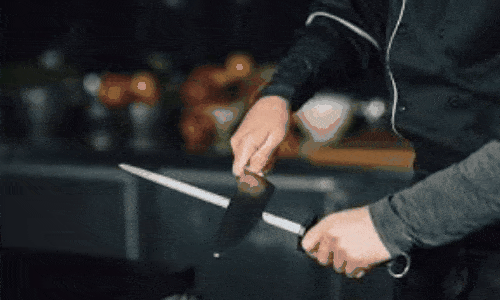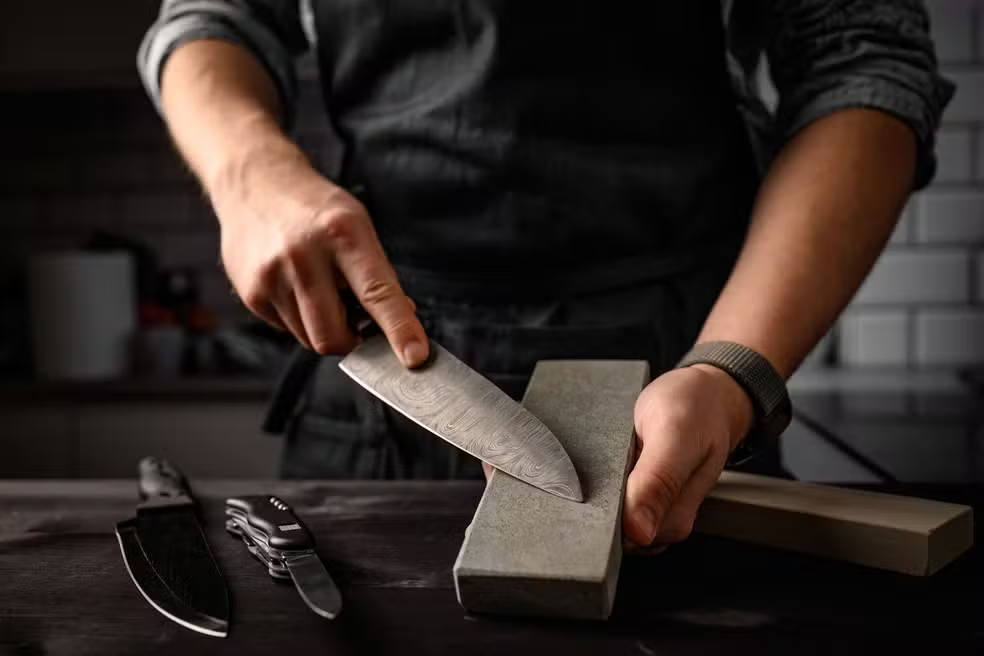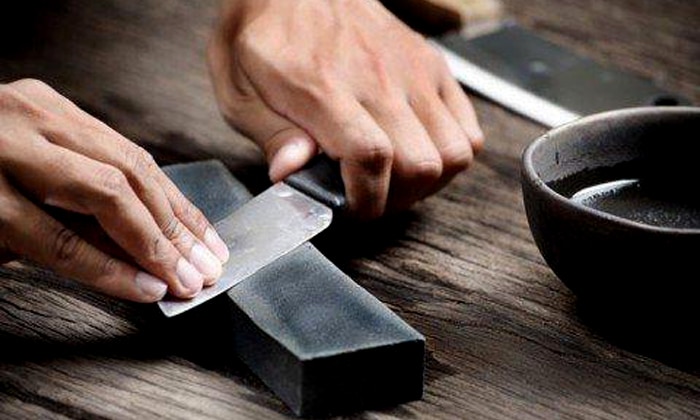Adverts
Keeping your knives sharp isn't just a matter of practicality in the kitchen, it's also a matter of safety and efficiency.

Sharp knives glide through food easily, require less effort, and ensure precise cuts. However, for many people, sharpening still seems like a complicated mystery. 😅
Adverts
The good news is that mastering the art of knife sharpening can be simpler than it seems. With the right techniques and a few practical tips, you can transform your blades without spending hours or needing expensive equipment.
And, even better, you can do it from the comfort of your own home!
Adverts
In this straightforward guide, you will learn:
- The main sharpening methods and how to choose the ideal one for each type of knife;
- Common mistakes to avoid to prevent damage to your blades;
- Essential tips to prolong the life of your knife's edge in everyday life;
- Essential tools that can make the process easier. 🛠️
With this content, you will have the knowledge you need to sharpen your knives efficiently and safely, even if you've never done it before.
Get ready to transform your kitchen routine and ensure impeccable results with every recipe. Shall we get started? 🔪✨

The Secret to Always Sharp Knives: It's Simpler Than It Seems! 🗡️
Did you know that a dull knife is more dangerous than a sharp one? Yes, my friend, because a dull one makes you use too much force, slips where it shouldn't, and ultimately, your finger ends up getting sliced. So, if you want to avoid the "hospital and stitches" combination, it's time to master the art of knife sharpening. But don't worry, you don't have to be a samurai or spend tons of money on futuristic equipment! We'll simplify this task with practical and straightforward tips, just the way you deserve.
What do you need to get started? Just the basics (and a little bit of enthusiasm)
Before you go out and rub your knife against every surface you can find (no, the edge of a plate is NOT a good idea), let's talk about the right equipment. You don't need a whole arsenal of sharpening tools, just the essentials:
Related articles:
- A steel: That metal wand that comes in knife sets and no one knows how to use. Spoiler: it doesn't sharpen, it just aligns the edge.
- A whetstone: This is the star of the show. It can be coarse or fine, depending on the condition of your knife.
- A portable sharpener: The practical option for those who don't want to play ninja, but want results.
Oh, and let's not forget the most important thing: your patience. Because sharpening a knife isn't for those in a hurry. It's almost like Zen meditation, only with blades involved. 🧘♂️
How Does Sharpening Work? A Step-by-Step Guide That's Easy
Step 1: Know your knife angle
The ideal angle for sharpening a knife generally ranges between 15° and 20°. How do you measure this? Well, you don't need an 8th-grade protractor. Just imagine a right angle (90°), cut it in half (45°), and then in half again. That's it! It doesn't have to be a NASA-worthy calculation, but keep it consistent.
Step 2: Lubrication is life
If you're using a sharpening stone, remember to wet it before you begin. Some stones work better with water, others require oil. Read the manufacturer's recommendations (or at least pretend you did). This helps reduce friction and improves the knife's glide. Think of it like applying moisturizer to your skin, only for the stone and blade. 💧
Step 3: Movement is everything
Now comes the magic. Position the blade on the stone at just the right angle and slide it in even motions, as if you were trying to spread butter on a giant, imaginary loaf of bread. Brute force isn't enough; the key is ease and repetition. Switch sides every four or five passes. Sound complicated? Think of it like running a knife through bread, except the bread is a rock, and the goal is to avoid eating any of it.

The Most Common Mistakes (And How to Avoid Them) 🛑
Mistake 1: Unnecessary pressure
Many people think they need to apply force to sharpen a knife, but that's a myth! Using too much pressure can wear the blade unevenly and even cause accidents. The tip here is: relax, relax your shoulders, and take a deep breath. Sharpening isn't like a UFC fight. 🥊
Mistake 2: Skipping maintenance
Oh, but the knife still cuts tomatoes, so why would I sharpen it? That's where the danger lies. Regular maintenance is key to preventing the blade from becoming as dull as I am without glasses. Use the sharpening steel weekly and avoid letting the knife reach the "it won't even cut through melted butter" stage.
Mistake 3: Using the wrong equipment
If you're using the back of a drawer or the edge of a plate to sharpen your knife, stop right now. These DIY methods may seem effective, but they actually damage the blade. Invest in a good sharpener or stone. Your fingers will thank you. 🙏

How to Know if Your Knife is Really Sharp? 🔪
Paper test
Take a piece of bond paper (the basic white kind). Hold it in one hand and run the blade lightly over it. If it cuts like butter, your knife is ready to shine. If it tears, back to the grindstone, my dear samurai apprentice.
Tomato test
Tomatoes are the king of the sharpness tests. They have delicate yet firm skin, making them perfect for this type of evaluation. Try slicing without applying pressure. If the knife glides and makes clean cuts, congratulations—you're officially in the hall of master sharpeners. 🥳
Touch carefully
If you're feeling adventurous, gently run your fingertip along the edge of the knife (be careful not to cut yourself!). A sharp knife has a consistent, sticky feel. If it's slippery, it needs more work.
Care and Tips to Extend the Life of Your Knives
Proper storage
Please don't throw your knife in the back of the drawer with can openers and wooden spoons. That's just asking for a dull edge. Use a magnetic holder, a sheath, or at least a decent organizer. This way, your knife will not only stay sharp longer but also prevent kitchen accidents. 🧲
Avoid hard surfaces
Cutting directly on marble, glass, or ceramic is like throwing your knife against a wall. Opt for wooden or plastic cutting boards. They're much gentler on the edge and also give your kitchen a cooking-show feel.
Hygiene is essential
Avoid washing your knives in the dishwasher. The heat and abrasive detergents can damage both the edge and the handle. Wash by hand with warm water and mild detergent. Dry immediately to prevent rust.
Turn Sharpening into a Hobby (Or a Party Trick)
Now that you know how to sharpen your knives, how about turning it into a hobby? Put on a relaxing playlist, pack your kit, and get started. And if you want to impress your friends at your next barbecue, give a demonstration. Nothing says "I know what I'm doing" like expertly sharpening a knife while everyone watches. Just don't overdo it and start spinning the knife in the air, circus juggler style. 🤹♂️
With these tips, you're ready to keep your knives sharp and transform your kitchen into a safe (and much more efficient) place. So, let's get sharpening! 🪒
Conclusion
Mastering the skill of sharpening knives is essential for anyone seeking practicality, efficiency, and safety in the kitchen. With our practical and straightforward guide, you will learn, in just a few minutes, the techniques necessary to keep your knives sharp and ready for use. 🔪
Whether you're a beginner or experienced, our simplified approach is designed to help everyone achieve fast, consistent results. Plus, mastering this art saves time, reduces the risk of accidents, and extends the life of your knives. 💡
Remember that sharp knives are not only more functional, but also offer more precise cutting, preserving the freshness and appearance of food. So, taking a few minutes to learn and apply these techniques will make all the difference in your daily life! 🔥
Now that you know how easy it is to master this skill, why wait any longer? Start putting what you've learned into practice and enjoy all the benefits of a more efficient and safe kitchen. 😉 Make this task a habit and see how it can revolutionize your cooking routine. Your utensils and your recipes will thank you! 🍽️




